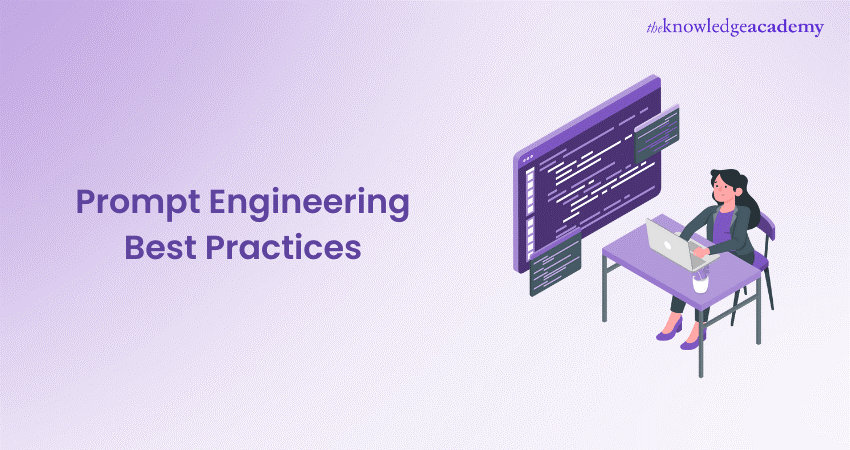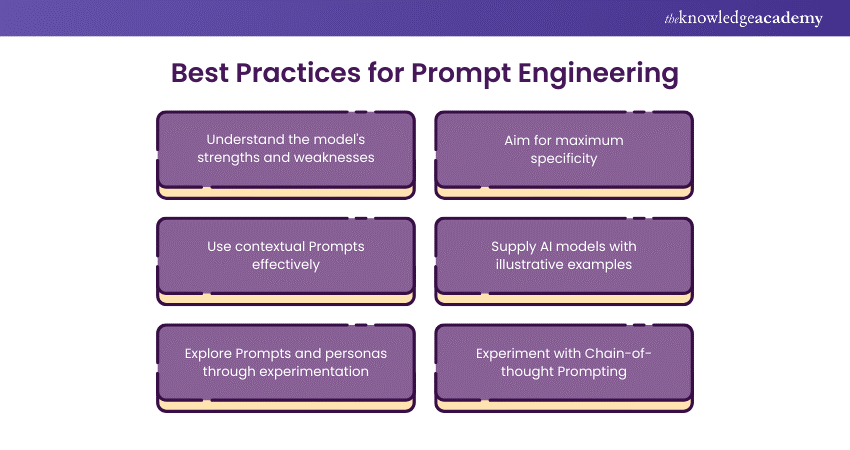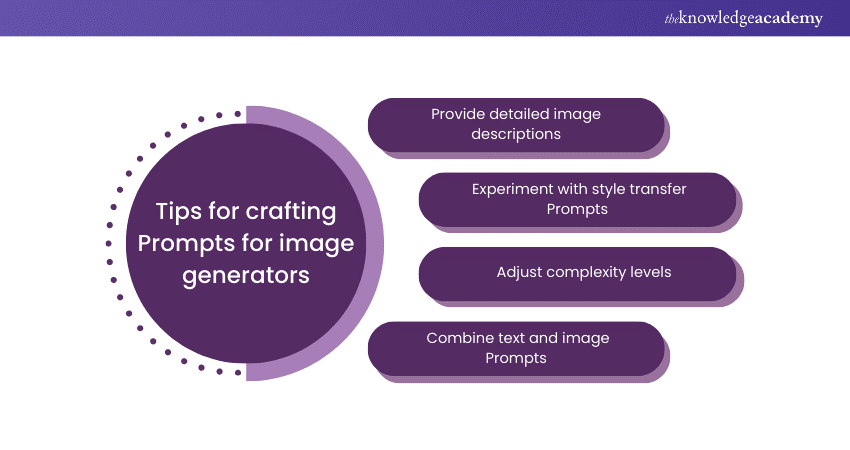We may not have the course you’re looking for. If you enquire or give us a call on +31 208081674 and speak to our training experts, we may still be able to help with your training requirements.
Training Outcomes Within Your Budget!
We ensure quality, budget-alignment, and timely delivery by our expert instructors.

Prompt Engineering has become increasingly significant in the ever-evolving landscape of Natural Language Processing (NLP) and Artificial Intelligence (AI). The art of crafting effective Prompts is a crucial aspect of building robust and efficient language models. This comprehensive guide will delve into the intricacies of Prompt Engineering Best Practices, exploring the fundamental principles, techniques, and considerations that can elevate your NLP projects to new heights.
Table of Contents
1) What is Prompt Engineering?
2) Best Practices for Prompt Engineering
a) Understand the model's strengths and weaknesses
b) Aim for maximum specificity
c) Use contextual Prompts effectively
d) Supply AI models with illustrative examples
e) Explore Prompts and personas through experimentation
f) Experiment with Chain-of-thought Prompting
3) Tips for crafting Prompts for image generators
4) Avoiding common mistakes
5) Conclusion
What is Prompt Engineering?
Prompt Engineering is the strategic art of creating clear and practical instructions to guide AI models in generating desired outputs. In the realm of Artificial Intelligence, it serves as the compass that directs models toward producing meaningful and accurate responses.
At its core, it is about employing Best Practices to communicate with AI systems. These Best Practices involve understanding the model's strengths and weaknesses, aiming for instruction specificity, and using contextual Prompts effectively. By adhering to Prompt Engineering Best Practices, developers can enhance the performance and reliability of AI models.
The key lies in crafting precise and considerate Prompts of the model's capabilities. It's like providing a well-defined roadmap, enabling the AI to navigate and respond appropriately. As technology advances, Prompt Engineering Best Practices become increasingly apparent, shaping how we interact and benefit from Artificial Intelligence.
Best Practices for Prompt Engineering
Navigating the vast landscape of Artificial Intelligence, Prompt Engineering emerges as a crucial compass, guiding the behaviour of language models. Adopting Best Practices in this field is imperative to harness the full potential of AI systems. In the upcoming sections, we'll delve into a comprehensive guide encompassing key strategies and techniques. These Best Practices are tools that empower developers and engineers to craft precise and effective Prompts.
From understanding the nuances of a model's strengths and weaknesses to employing Chain-of-thought Prompting, each practice is a stepping stone toward mastering the art of Prompting. Let's embark on a journey to explore and implement these practices, ensuring that our interactions with AI yield not just responses but meaningful and contextually rich insights. Through adherence to these Best Practices, we pave the way for a more refined and impactful integration into the fabric of Artificial Intelligence.

Understand the model's strengths and weaknesses
Before embarking on Prompt Engineering, it's crucial to have a profound understanding of the AI model's capabilities and limitations. Different models excel in various tasks, and being aware of these nuances allows prompt engineers to tailor Prompts to leverage the model's strengths while mitigating its weaknesses.
Aim for maximum specificity
Specific Prompts yield specific results. To enhance the precision of AI outputs, engineers should craft Prompts with clarity and specificity. Vague or ambiguous instructions may lead to unpredictable or undesired results. Accuracy in language is critical to achieving the desired outcome.
Use contextual Prompts effectively
Context is a powerful tool. Engineers can guide models to produce contextually accurate and coherent responses by providing relevant context in Prompts. Understanding context's importance helps generate more contextually relevant and meaningful outputs.
Supply AI models with illustrative examples
Training models become more effective when accompanied by illustrative examples. Engineers should incorporate diverse and representative examples in Prompts to guide the model's learning process. Real-world scenarios and varied contexts enrich the model's understanding, leading to more robust and versatile outputs.
Explore Prompts and personas through experimentation
Prompt Engineering is an iterative process. Experimentation is key to discovering optimal Prompts and personas. Engineers should be willing to explore different Prompt variations and personas to fine-tune the model's responses. Continuous experimentation refines the process and enhances the model's performance.
Experiment with Chain-of-thought Prompting
Chain-of-thought Prompting involves structuring Prompts logically to guide the model's thought process. This technique proves beneficial for tasks requiring sequential reasoning. Engineers can experiment with chaining Prompts to navigate the model through complex scenarios, ensuring coherent and logical responses.
Master the AI skills with our Generative AI in Prompt Engineering Training – Sign up today!
Tips for crafting Prompts for image generators
In Artificial Intelligence, Prompt Engineering Best Practices extend beyond the boundaries of natural language processing, embracing the vivid world of image generation. Crafting Prompts for image generators involves a nuanced approach, weaving together a tapestry of detailed instructions and innovative techniques.

1) Provide detailed image descriptions:
Compelling image Prompts demand clarity. Prompt Engineering Best Practices ensure a roadmap for image generation by meticulously articulating desired elements, colours, and composition. This precision becomes the cornerstone for guiding the model in producing visually accurate and contextually relevant images.
2) Experiment with style transfer Prompts:
Dive into the realm of artistic influence by experimenting with style transfer Prompts. Including style-related instructions introduces a creative dimension and influences the artistic rendering of generated images. This facet of Prompt Engineering Best Practices enables a fusion of technical prowess with aesthetic finesse.
3) Adjust complexity levels:
Tailoring Prompts to control the complexity of generated images is a hallmark of excellence. Engineers fine-tune the model to align with specific project requirements by adjusting parameters such as detail level and intricacy. This adaptive approach ensures that image generators produce outputs that meet the desired level of sophistication.
4) Combine text and image Prompts:
Seamlessly blending textual and visual Prompts represents a pinnacle in Prompt Engineering Best Practices for image generation. This holistic approach provides comprehensive guidance, allowing the model to synthesise information from both domains. The synergy between text and image Prompts results in a more nuanced understanding, enabling the generation of images that align seamlessly with specific textual descriptions.
As we navigate the expanding horizons of Prompt Engineering Best Practices, these tips for crafting Prompts for image generators stand as a testament to the versatility and adaptability of this evolving field. By embracing these practices, we not only elevate the quality of generated images but also push the boundaries of what Artificial Intelligence can achieve in the visual realm.
Stay at the forefront of AI Skills with our Generative AI in Software Development Training - Join today!
Avoiding common mistakes
While navigating the field of Prompt Engineering, it's essential to be aware of common pitfalls and mistakes that can hinder the effectiveness of AI models.
1) Overlooking model biases: Failing to address and mitigate biases present in the model can result in outputs that perpetuate or amplify existing biases. Vigilance in identifying and correcting biases is crucial for ethical, Prompt Engineering.
2) Neglecting negative examples: Providing only positive examples in Prompts may lead to over-optimistic models that need help handling diverse scenarios. Including negative examples helps in training models to recognise and handle edge cases.
3) Ignoring experimentation: It is an evolving field, and sticking to conventional approaches without exploring new ideas stifles progress. Embrace a mindset of continuous experimentation to discover innovative strategies.
4) Underestimating contextual sensitivity: Models may exhibit sensitivity to subtle changes in context. Underestimating the impact of context can result in unexpected or undesired outputs. Carefully considering contextual nuances is vital for practical, Prompt Engineering.
Boost your career with our comprehensive Artificial Intelligence Tools Training. Sign up today!
Conclusion
Prompt Engineering is vital in AI's ever-changing landscape, unlocking language models' potential. Elevate it with practices like understanding strengths, aiming for specificity, using context, providing examples, and embracing experimentation. Be mindful of common mistakes for ethical and practical Prompt Engineering. Whether for language or image tasks, these principles form a sturdy foundation. As technology evolves, Prompt Engineering's role remains pivotal, shaping AI's future. It's about following Prompt Engineering Best Practices for optimal results and progress in the field.
Become the master of AI with our Generative AI Course – Sign up today!
Frequently Asked Questions

Understanding the model's strengths and weaknesses is essential as it allows engineers to tailor Prompts effectively, leveraging the model's capabilities while mitigating its limitations. This knowledge forms the basis for crafting Prompts that yield optimal and reliable AI responses.

Experimentation is key in Prompt Engineering. Trying different Prompt variations and personas refines the model's responses, guiding engineers towards innovative and effective strategies. Continuous experimentation fosters adaptability, ensuring it remains dynamic in the ever-evolving landscape of Artificial Intelligence.

The Knowledge Academy takes global learning to new heights, offering over 30,000 online courses across 490+ locations in 220 countries. This expansive reach ensures accessibility and convenience for learners worldwide.
Alongside our diverse Online Course Catalogue, encompassing 17 major categories, we go the extra mile by providing a plethora of free educational Online Resources like News updates, Blogs, videos, webinars, and interview questions. By tailoring learning experiences further, professionals can maximise value with customisable Course Bundles of TKA.

The Knowledge Academy’s Knowledge Pass, a prepaid voucher, adds another layer of flexibility, allowing course bookings over a 12-month period. Join us on a journey where education knows no bounds.

The Knowledge Academy offers various Artificial Intelligence and Training Courses, including Generative AI training, Practitioner, and Agile. These courses cater to different skill levels, providing comprehensive insights into ChatGPT Prompt Engineering Certification methodologies.
Our Data Analytics and AI Blogs cover a range of topics related to AI technology, offering valuable resources, Best Practices, and industry insights. Whether you are a beginner or looking to advance your AI skills, The Knowledge Academy's diverse courses and informative blogs have you covered.
Upcoming Data, Analytics & AI Resources Batches & Dates
Date
 ChatGPT Course
ChatGPT Course
Fri 14th Feb 2025
Fri 11th Apr 2025
Fri 13th Jun 2025
Fri 15th Aug 2025
Fri 10th Oct 2025
Fri 12th Dec 2025







 Top Rated Course
Top Rated Course



 If you wish to make any changes to your course, please
If you wish to make any changes to your course, please


